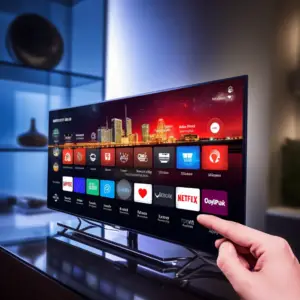When your Samsung TV turns on itself, it can be pretty alarming the first time. It might be the last time, too. The problem is that a couple of different issues could cause this to happen.
Table of Contents
Samsung TV Turns on by Itself: Possible Issues

And since there are several things causing it, the fixes will not all be the same. In this post, we will walk you through each possible issue so that you can make a fix for your specific issue.
Check for Power Surges
If your Samsung television turns on itself, you might have a problem with the power supply. The best way to check for this is to unplug the cord from both ends and plug it back in. If the TV turns on, you have a problem with your power supply.
The next step is to check for power surges and ensure that all your electronics are properly grounded. You can use a voltage tester or an outlet checker to do this. If there are any problems with your outlet, they should be replaced as soon as possible.
If there are no problems with your outlets or power supply system, then it might just be that your remote control needs to be replaced.
Update the Software
If your Samsung TV is turning on by itself again and not responding to remote commands, it may be time to update the software. Samsung recommends always using their Smart Hub app to update your TV’s software. The app can be downloaded from the Google Play Store or Apple App Store.
If you have a newer model of Samsung TV, you should already have access to the Smart Hub app, so follow these steps:
- Open the Smart Hub app and connect to your TV using your phone’s Wi-Fi network.
- Select Software Update from the menu on the left side of the screen and click Download & Install Now. The update will begin automatically once it’s downloaded. You’ll see an update notification on your TV when it’s complete.
Disable Sleep Timer
The sleep timer is a useful feature that automatically turns off your Samsung smart TV once the time is up. It’s supposed to help you fall asleep while watching your favorite TV show or movie, but it can become annoying if it’s not working properly. If you find yourself constantly having to restart or reset your Samsung smart TV because of this issue, there are a few things you can try to correct it.
Reset the Sleep Timer
If your Samsung smart TV keeps turning off after a certain time, even though you haven’t told it to, there may be an issue with the sleep timer itself. The first thing to try is resetting the sleep timer using one of two methods:
- Press and hold the button on the remote until “Off” appears onscreen. Then press and hold this same button for three seconds until Sleep Timer Off appears onscreen. This will reset all settings back to default.
- Press Settings gear icon > General > Reset > Reset All Settings > Yes > OK.
Allow Your Samsung Smart TV to Update
If you have a Samsung Smart Hub account set up on your television, you can allow your Samsung Smart TV to update automatically over the internet. This is convenient and easy, but it does increase the risk that someone else could gain access to your TV. We recommend disabling this feature if you are concerned about privacy or security when using your Samsung Smart TV.
To turn on Auto Updates for Your Samsung Smart TV:
- Open the menu on your Samsung Smart TV by pressing the “Menu” button on your remote.
- Select Settings from the menu options.
- Select Support > Software Update > Auto Update > On (enabled).
Update the Firmware
Samsung TV Eco Mode is a power-saving feature that can reduce your TV’s energy consumption. It will automatically turn off some features on the TV to save electricity.
Eco mode does not affect your viewing experience or picture quality and will not cause your TV to turn off by itself.
To disable Eco mode on your Samsung TV:
- Press the information button on the remote control or the Home button. The Information screen appears.
- Scroll left and select Eco Mode from the list of options
- Scroll down and press MENU/ENTER. Select Disable Eco Mode and press MENU/ENTER again.
Check that the IR Sensor isn’t Obstructed

The IR sensor detects the remote control’s signal and sends it to the TV. Point a remote control at your TV to check if it’s blocked and press any button. If nothing happens, your problem may be caused by a faulty remote control or battery.
The most likely cause is that the infrared sensor on your remote has become dirty or obstructed in some way; there are other causes as well. The infrared sensor enables your remote to control your TV by sending signals through the air; when those signals are blocked or interrupted, your TV won’t listen to the commands.
Here’s how to fix it:
- Remove batteries from your remote and clean all exposed surfaces with a dry cloth or cotton swab dipped in rubbing alcohol. Wipe down the battery compartment, too, then put new batteries back in and try again.
- If that doesn’t work, try pointing your remote directly at the IR sensor on the front of your TV; it looks like a little red dot, and make sure there aren’t any obstacles between them.
Disable Anynet+ HDMI-CEC
The Anynet+ HDMI-CEC function is a convenient feature that allows you to control your Samsung TV’s connected devices using the TV remote. However, if you’re having problems with Anynet+, such as when your TV turns on by itself, here are a few steps you can take to resolve the issue:
Disable Anynet+ HDMI-CEC. There’s a chance the problem lies with your external device rather than your TV. To disable Anynet+, follow these steps:
- Press MENU on your remote control and select System > General > Anynet+ HDMI-CEC.
- Select Off from the drop-down menu and press ENTER.
Final word
Once you identify the device causing interference and if other Samsung TV owners are experiencing similar issues, you can decide whether to continue using the device or return it. If more than one Samsung TV is experiencing the same problem, there is clearly an issue with your TV. However, we recommend you check out the above troubleshooting tips to ensure you address all of your Samsung TVs’ issues.


